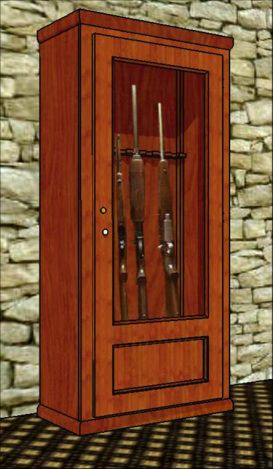
Building a Secure Wooden Gun Cabinet
Owning firearms comes with the responsibility of storing them safely and securely. A well-constructed gun cabinet is essential for protecting your weapons from theft, unauthorized access, and accidental discharge. This comprehensive guide will walk you through the process of building a robust wooden gun cabinet with advanced locking features, ensuring the utmost security for your firearms.
Planning and Design
Before you begin construction, meticulous planning is crucial for a successful project. Here's a breakdown of essential considerations:
Size and Capacity
Determine the number of firearms you need to store and their dimensions. Measure the length, width, and height of your largest firearm to ensure ample space within the cabinet. Consider future additions to your collection and allow for potential growth. A standard gun cabinet size is 36 inches wide, 18 inches deep, and 60 inches tall, but adjust these dimensions based on your specific needs.
Materials
Select high-quality materials for both durability and security.
- Cabinet Body: Utilize hardwood like oak, cherry, or maple for structural integrity and resistance to warping. Plywood can be used for the internal shelves and back panel, ensuring stability.
- Locking Mechanism: Invest in a heavy-duty, high-quality lock with multiple deadbolts for enhanced security.
- Hardware: Choose sturdy hinges, handles, and other hardware that will withstand frequent use and potential attempts to force entry.
Design Features
Plan your cabinet's internal layout and security features:
- Shelving: Create adjustable shelves to accommodate different firearm sizes. Ensure sufficient space between shelves to prevent accidental contact and potential damage.
- Interior Lighting: Install a small LED light inside the cabinet for easy visibility of your firearms. Consider a motion-activated light for added convenience.
- Cable Management: If you plan to include a dehumidifier or other electronic devices, integrate cable management features to maintain a clean and organized interior.
Construction Process
Once you have finalized your design and gathered the necessary materials, you can begin construction. The following steps provide a detailed guide:
Cutting and Assembly
1. **Cut Cabinet Panels:** Using precise measurements, cut the panels for the cabinet sides, top, bottom, and back. Use a table saw or circular saw for accurate cuts. 2. **Assemble Cabinet Frame:** Create a strong and stable frame using rabbet joints or mortise and tenon joints. Use glue and screws to secure the joints. 3. **Add Interior Features:** Cut and install the shelves, back panel, and any other internal features based on your design. 4. **Secure Locking Mechanism:** Choose the location for your lock and carefully install it on the door. Ensure the locking mechanism is flush with the door surface.
Finishing Touches
1. **Sanding and Staining:** Sand the cabinet surfaces smooth and apply a stain or paint to enhance its aesthetic appeal and provide a protective finish. Consider applying multiple coats of clear polyurethane for increased durability and moisture resistance. 2. **Install Hardware:** Attach hinges, handles, and any other desired hardware. Make sure hinges are mounted securely to the cabinet and door for a smooth and reliable opening and closing mechanism. 3. **Add Security Features (Optional):** Consider adding additional security features for enhanced protection. * **Locking Bolts:** Install heavy-duty locking bolts that engage with the floor or wall for added resistance to forced entry. * **Security Camera:** Mount a security camera inside or outside the cabinet to monitor access and deter theft. * **Alarm System:** Connect the cabinet to a home security system for real-time alerts in case of unauthorized entry.
Securing Your Gun Cabinet
A secure gun cabinet is only as effective as its installation and placement. Consider the following points to maximize protection:
Installation
1. **Wall Anchors:** Utilize strong wall anchors to secure the cabinet to the wall. This prevents the cabinet from being lifted or removed without damaging the wall. 2. **Heavy-Duty Hardware:** Use heavy-duty bolts or lag screws to attach the cabinet to the wall. 3. **Floor Anchors (Optional):** Install floor anchors to prevent the cabinet from being pulled away from the wall. This is especially important for heavier cabinets.
Placement
1. **Visibility:** Place the cabinet in a highly visible location, preferably within sight of a window or security camera. 2. **Solid Surface:** Install the cabinet on a solid, stable surface that can withstand its weight. 3. **Concealed Area:** Consider placing the cabinet in a hidden area, such as a closet or behind a heavy piece of furniture, to deter potential thieves.
Maintaining Your Gun Cabinet
Regular maintenance is vital to ensure your gun cabinet remains functional and secure. Here are some key practices:
Inspection and Cleaning
1. **Regular Inspection:** Inspect the cabinet regularly for any signs of wear, damage, or loosening of hardware. 2. **Cleaning:** Keep the interior and exterior of the cabinet clean and free of dust and debris. Use a soft cloth and mild cleaner to avoid damaging the finish. 3. **Lock Lubrication:** Apply a light lubricant to the lock mechanism to ensure smooth operation and prevent jamming. 4. **Shelf Adjustment:** Adjust shelves as needed to accommodate changes in your firearm collection.
Addressing Issues
1. **Replace Damaged Parts:** Promptly replace any damaged or worn parts, such as hinges, handles, or locks. 2. **Secure Loose Hardware:** Tighten any loose hardware to prevent potential failure. 3. **Re-secure Cabinet:** Re-secure the cabinet to the wall or floor if any anchors or fasteners become loose.
Safety Precautions
Always prioritize safety when handling firearms. Never store loaded firearms in a gun cabinet.
- Unloaded Firearms:** Ensure all firearms are unloaded before storing them in the cabinet.
- Trigger Lock:** Consider using a trigger lock to prevent accidental discharge.
- Ammunition Storage:** Store ammunition separately from firearms in a secure location within the cabinet or in a dedicated ammunition safe.
Building a secure wooden gun cabinet requires careful planning, quality materials, and meticulous craftsmanship. By following this comprehensive guide, you can create a safe and reliable storage solution for your firearms, ensuring their protection and preventing unauthorized access.

0 comments:
Post a Comment